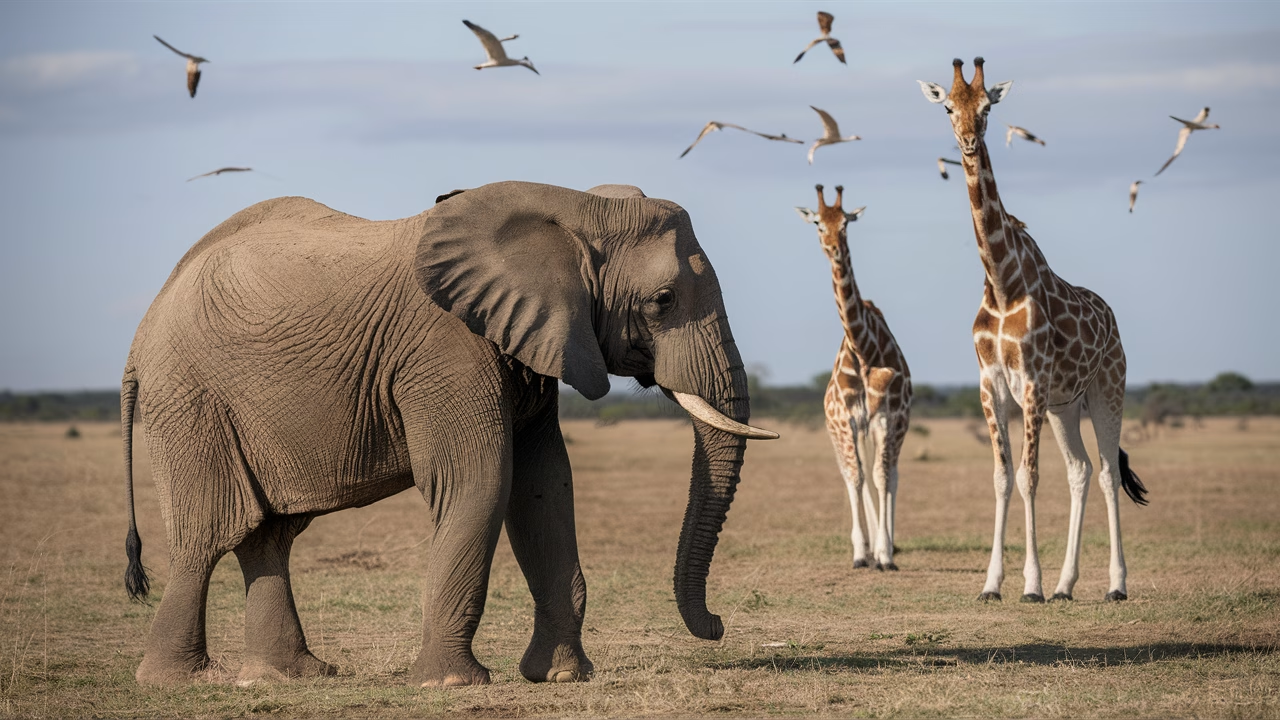How Do Elephants Communicate Using Infrasound?
Elephants communicate through a rich tapestry of auditory signals—including infrasonic soundwaves that travel miles, far below human hearing thresholds. These powerful communication tools enable them to maintain social bonds, find mates, and warn each other of threats across vast landscapes, demonstrating one of nature’s most sophisticated long-distance communication systems.
TL;DR:
- Elephants communicate through vocalizations, touch, body language, and infrasound frequencies.
- They produce infrasound—low-frequency soundwaves that can travel miles, operating below human hearing range at frequencies under 20 Hz.
- This type of animal communication proves invaluable for coordinating movement, signaling danger, and fostering long-distance bonds in herds.
- Scientific studies reveal how infrasound affects wildlife behavior and the collective social decisions of elephant groups.
- Understanding elephant communication unlocks insights into broader patterns across species in infrasound communication in wildlife.
How Elephants Use Infrasound Communication to Coordinate Across Miles
The Science Behind Elephant Infrasound: More Than Just Trumpeting
When we think of how elephants communicate, most of us picture their loud trumpets echoing across the savannah. But beneath these audible sounds lies another complex and hidden language: infrasound. Produced in the larynx and resonated via the trunk, these soundwaves register at frequencies below human hearing—deep vibrations that we humans can’t detect audibly but might feel underfoot, like a distant drumbeat reverberating through the ground.
Infrasound travels more efficiently than higher frequencies, allowing it to span distances of up to 10 kilometers. This makes it ideal for long-range animal communication—an evolutionary adaptation for creatures whose territory can stretch across hundreds of square miles. Researchers describe elephant infrasound as being similar to a subwoofer at a concert: you may not hear the sound explicitly, but you can feel its pressure physically moving through you, demonstrating the significance of infrasound in animal behavior.
Why Use Infrasound? Surviving and Thriving in Wide Open Spaces
Living in open savannahs, dense forests, and deserts, elephants aren’t casually social—they’re deeply bonded. But what happens when individuals or groups drift several miles apart? Standard vocalizations won’t reach that far. Here, infrasound steps in as nature’s biological communication network, allowing elephants to “talk” in sophisticated and nuanced ways across vast distances.
Key functions of infrasound signals in wildlife behavior include:
- Mating calls: Females in estrus emit infrasonic calls to attract distant males, broadcasting below human hearing frequencies.
- Navigation coordination: Herd leaders signal movement plans, redirecting groups without visible cues through infrasound communication.
- Distress signals: Elephants in trouble issue urgent low-frequency calls requesting aid or alerting others to problems.
- Greeting rituals: Reunions between separated family members often begin with cascades of low rumbles, initiating tactile and visual contact.
Examples of Infrasound in Action: Real-Life Elephant Conversations
Let’s examine vivid instances that illustrate infrasonic animal communication in action:
- Early Detection of Natural Disasters: Elephants have been observed moving away from coastal zones prior to tsunamis. How? Scientists hypothesize they detect infrasonic foreshocks generated by seismic waves or distant thunder—a survival tool demonstrating how soundwaves below human hearing serve critical functions.
- Cross-Herd Contact: A matriarch in one herd may detect infrasonic calls from another group over 5 miles away and choose to approach or avoid. These decisions aren’t random; they’re informed choices shaped by vocal memory and emotional intelligence embedded in sound.
- Mother-Calf Bonding: Young elephants respond particularly well to their mother’s gentle rumbles—infrasonic communication that functions like a lullaby. Calves follow these vibrations and tones, ensuring they stay close even in low visibility conditions.
What Research Reveals: Breakthroughs in Elephant Communication
Our understanding of infrasonic elephant communication has expanded tremendously thanks to advances in acoustic monitoring and seismic sensors. Studies using directional microphones and audio mapping demonstrate that elephants are capable of voice-print discrimination—much like humans recognizing individual voices through their unique acoustic signatures.
In one breakthrough study, researchers observed that elephants in Botswana used infrasonic calls not just to organize their own group but to influence movements of other nearby herds, suggesting sophisticated inter-group decision-making. This supports the idea that elephant societies are more interconnected than previously realized—bound by threads of infrasound communication in wildlife that we can only study through specialized technology.
Another significant advancement involves recognizing how noise pollution impacts elephant communication. Habitat encroachment and human-made noise—like vehicle traffic or machinery vibration—can interfere with infrasound transmission, much like static disrupting a phone call. This interference potentially has far-reaching consequences for mating, migration, and survival, highlighting the significance of infrasound in animal behavior.
How Infrasound Shapes Wildlife Behavior Beyond Elephants
While elephants excel in this acoustic realm, they’re not alone. Infrasound communication in wildlife has been documented in whales, rhinoceroses, alligators, and even some big cats. In elephants, it’s especially well-developed due to their social complexity and spatial ranges, but examining patterns across species provides insights into why this evolutionary trait developed.
Studies in animal behavior increasingly suggest that infrasound isn’t just about size or strength—it may correlate with cognitive complexity. Long-range infrasound communication appears tied to advanced memory, social hierarchy, and emotional language among animals, demonstrating how soundwaves below human hearing facilitate complex behavioral patterns.
| Species | Uses of Infrasound | Distance Covered |
|---|---|---|
| Elephants | Mating, migration, alerts | Up to 10 km |
| Whales | Navigation, long-distance songs | Over 100 km (underwater) |
| Alligators | Territorial display, mating | Several hundred meters |
The Significance of Infrasound in Animal Behavior
Understanding infrasound communication extends far beyond elephants—it opens windows into the super-sensory world of wildlife behavior. These sonic connections challenge our perceptions of how animals experience time, space, and social relationships. For elephants, infrasound isn’t simply a communication method—it’s fundamental to their way of life and social structure.
Habitat fragmentation, climate changes, and illegal hunting threaten not just elephant populations but the very communication networks that hold their societies together. Protecting elephant habitats means preserving the frequency pathways they use to greet, warn, love, and lead—ensuring that these remarkable soundwaves below human hearing continue to coordinate elephant communities across miles of African landscape.
Comparison Chart: Elephant Communication vs. Other Wildlife
| Communication Mode | Elephants | Primates | Whales |
|---|---|---|---|
| Infrasound | ✔️ Key mode, long-distance use | ❌ Not commonly used | ✔️ Critical for deep-sea navigation |
| Visual Signals | ✔️ Ear flapping, trunk gestures | ✔️ Facial expressions, posture | ❌ Limited visibility underwater |
| Tactile | ✔️ Trunk touches, close contact | ✔️ Grooming as bonding | ❌ Rare, except in calves |
Frequently Asked Questions
How do elephants produce infrasound?
Elephants generate infrasonic soundwaves using their larynx. Specialized muscles adjust vocal cord tension to create slow vibrations, producing frequencies below human hearing at under 20 Hz.
Can humans detect infrasound?
Humans can’t hear infrasound directly, but some people may feel it as pressure or vibration. Scientists use specialized equipment like seismic sensors to record and study these low-frequency communications.
How far can elephant infrasound travel?
Depending on terrain and weather conditions, elephant infrasound can travel up to 10 kilometers, enabling remarkable long-range communication among herd members across vast distances.
What affects infrasound clarity for elephants?
Environmental noise from traffic and engines, dense vegetation, and geological features can distort or dampen infrasonic signals, reducing their effectiveness for animal communication.
Is infrasound used outside of elephants?
Yes! Infrasound communication appears throughout wildlife—whales, rhinoceroses, and even giraffes use it. Each species has adapted this below human hearing communication for unique behavioral and environmental needs.





